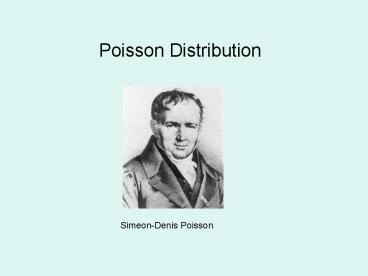Poisson Distribution - PowerPoint PPT Presentation
1 / 11
Title:
Poisson Distribution
Description:
What is the probability of x worms being in a particular quadrat? Use a Poisson distribution ... Probability of finding X worms in a quadrat # of worms ... – PowerPoint PPT presentation
Number of Views:1861
Avg rating:3.0/5.0
Title: Poisson Distribution
1
Poisson Distribution
Simeon-Denis Poisson
2
Quadrat
of worms
Consider the following problem
Sampling earthworms
25 plots
3
Quadrat
of worms
N 25 X 2.24 worms/quadrat
4
What is the expected number of worms/quadrat? OR
What is the probability of x worms being in a
particular quadrat?
5
- Use a Poisson distribution
- gt2 mutually exclusive categories
- N is relatively large and p is relatively small
- The distribution of worms in space is expected to
be random
6
Formula for a Poisson distribution
True mean of the population (approximated by
sample mean)
Probability of observing X individuals in a
category
µx X!
Px e-µ
An integer (number of indviduals)
Base of natural logarithms ( 2.71828.)
7
Formula for a Poisson distribution
Probability of observing X worms in a quadrat
µ X 2.24
µx X!
Px e-µ
Number of worms)
Base of natural logarithms ( 2.71828.)
8
Could go on forever or to 8 - whichever comes
first!
9
Practically.
P0 P1 P2 P3 P4 P5 P6 P7 .998
And P8 P9 .002 For convenience - P8
.002
10
Other kinds of Poisson problems 1. Cell counts
in a hemocytometer 2. Number of parasitic mites
per fly in a population 3. Number of fish per
seine 4. Number of animals in a particular
subdivision of the habitat Poisson Distributions
are very common in biological work!
11
SUMMARY
Problem - trying to determine the expected
frequencies of any result in a particular
experiment
Type of data
Discrete
Continuous
Other distributions
2 categories Bernoulli process
gt 2 categories
Use a Poisson distribution to calculate expected
frequencies
Use a Binomial model to calculate expected
frequencies































